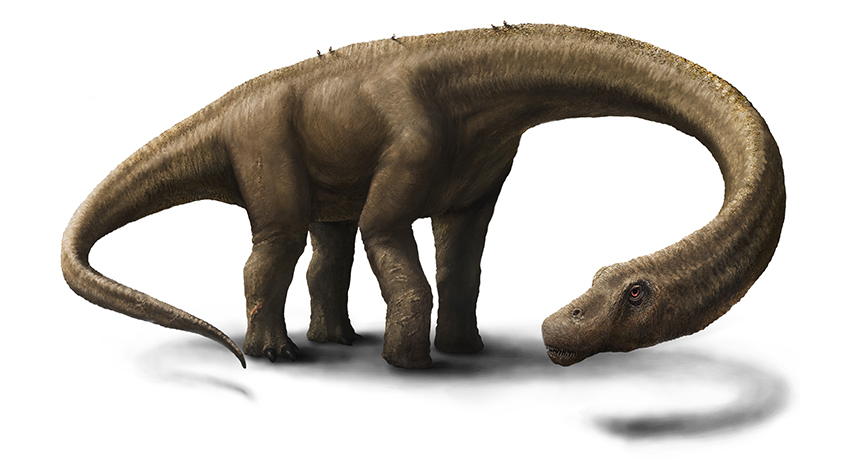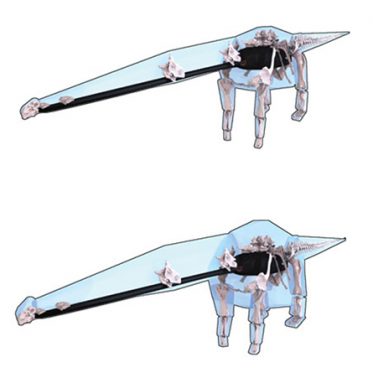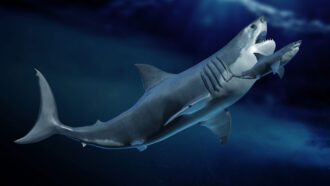New analysis halves massive dino’s weight
Dreadnoughtus may not have been as hefty as first estimated

The gigantic dinosaur Dreadnoughtus schrani may not have weighed as much as scientists first thought. A new analysis puts its weight at perhaps just 22,000 kilograms (24 tons).
Jennifer Hall
By Meghan Rosen
One of the world’s heaviest dinosaurs just slimmed down — in a jiffy.
Scientists announced the discovery of Dreadnoughtus schrani last year. At the time, this plant-eating dinosaur was estimated to have weighed about 59,000 kilograms (65 U.S. tons). But a newer analysis now suggests Dreadnoughtus (Dred-NAW-tus) probably weighed only about half that much. Details appeared online June 9 in Biology Letters.
The first estimate of this dino’s heft placed it among the largest land animals to have ever lived. Instead, it may have been only a little bit bigger than a related dinosaur, Apatosaurus. That is according to study coauthor Karl Bates. He is a biologist at the University of Liverpool in England.
“It’s not the sort of game-changing, massive difference that it was built up to be,” Bates says. Dreadnoughtus and Apatosaurus were both sauropods. Dinosaurs in this group had long necks and tails. They walked on four legs. And they were enormous.

Kenneth Lacovara is a paleontologist at Drexel University, in Philadelphia, Pa. His team announced finding Dreadnoughtus last year. At that time, these experts also shared their estimate of the dino’s likely weight. They arrived at their number using measurements of the circumference of the longest bones in the dino’s hind legs and forelegs.
Bates now says Lacovara’s team didn’t factor in the possibility for error. Bates and his colleagues tried a different method. They used a computer program and measurements from living animals. First, they estimated the volume of Dreadnoughtus. Next, the team calculated the dino’s mass. They conclude that Dreadnoughtus might have weighed between 22,000 and 38,000 kilograms (24 to 42 U.S. tons).
Lacovara isn’t convinced. The method used by Bates relies on a lot of guesswork, he charges. Scientists don’t have a complete Dreadnoughtus skeleton. Only about half of its bones had been found preserved as fossils.
An incomplete set of bones means the new study’s authors had to guess how chubby Dreadnoughtus was. They also had to guess at the proportions of the dinosaur’s skeleton. Even small changes in the animal’s length could lead to vast changes in its overall body volume, Lacovara points out.
In contrast, Lacovara says, all that his team did was “walk up to two bones with a tape measure and take a measurement. So there was zero opportunity for subjectivity.”
“We’re never going to be able to put Dreadnoughtus on a scale,” he says. Still, he argues that the method his team used to estimate the dinosaur’s mass, last year, has been “the gold standard.”
Power Words
(for more about Power Words, click here)
Apatosaurus A dinosaur whose name means deceptive lizard. It has a long neck and thick, whip-like tail. Formerly known as a brontosaurus, it lived during the Jurassic period, about 150 million years ago. In adulthood, this plant-eater would have weighed some 36 metric tons and had an average length of perhaps 23 meters (75 feet). That would have made it one of the largest animals to ever roam the Earth.
biology The study of living things. The scientists who study them are known as biologists.
circumference The size of a circle or other geometric object by measuring the distance all of the way along its outer edge.
dinosaur A term that means terrible lizard. These ancient reptiles lived from about 250 million years ago to roughly 65 million years ago. All descended from egg-laying reptiles known as archosaurs. Their descendants eventually split into two lines. They are distinguished by their hips. The lizard-hipped line became saurichians, such as two-footed theropods like T. rex and the lumbering four-footed Apatosaurus (once known as brontosaurus). A second line of so-called bird-hipped, or ornithischian dinosaurs, led to a widely differing group of animals that included the stegosaurs and duckbilled dinosaurs.
femur In humans, the large bone in the upper leg. It is commonly known as the thighbone. In tetrapods (creatures with four limbs), it’s the large bone in the upper hind limbs.
fossil Any preserved remains or traces of ancient life. There are many different types of fossils: The bones and other body parts of dinosaurs are called “body fossils.” Things like footprints are called “trace fossils.” Even specimens of dinosaur poop are fossils.
humerus The long bone found in the upper arm or forearm of an animal.
mass A number that shows how much an object resists speeding up and slowing down — basically a measure of how much matter that object is made from. For objects on Earth, we know the mass as “weight.”
paleontology The branch of science concerned with ancient, fossilized animals and plants. The scientists who study them are known as paleontologists.
sauropod A very large, four-legged, plant-eating dinosaur with a long neck and tail, small head and massive limbs.







